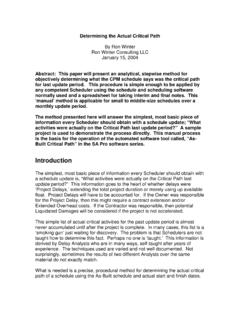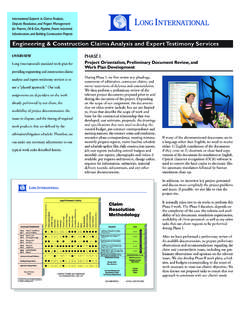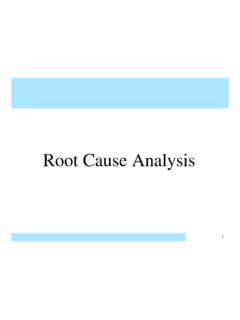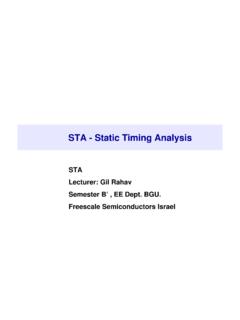Transcription of Time Impact Analysis - Ron Winter Consulting LLC
1 time Impact Analysis By Ron Winter , PSP December 9, 2004 Overview Unplanned delays on a construction project are often regrettable but unavoidable. If the General Contractor has been harmed by the effects of an event beyond his ability to reasonably foresee and plan for in his bid, then the Owner should adjust the contact in a fair and equitable manner. It is desired that this adjustment to the contract be accomplished as quickly and with the least amount of effort as possible. Construction law in most localities require the injured party (in this case the General Contractor) to petition for equitable adjustment of contractual terms if they feel that they have been harmed.
2 To this goal, may contracts specify that time Impact Analysis be prepared and submitted to objectively substantiate the contractor s claim for equitable time adjustment. Once the issue of time has been agreed upon, then if all directs costs have been resolved then the final costs of such a delay can be determined. time Impact Analysis (TIA) is a simplified Analysis procedure typically specified on construction projects to facilitate the award of excusable days to project completion due to delays that were not the responsibility of the General Contractor (contractor.) time Impact Analysis is typically associated with the modeling of the effects of a single delay.
3 It requires a CPM schedule that is able to show the pure CPM calculation differences between a schedule that does not include a delay and one that does include an activity modeling a delay. The difference for project completion between the non-impacted schedule and that of the schedule with the Impact is considered to be the Impact of the delay for time duration considerations. TIA is more useable as a forward-looking took than as a backward-looking tool. This is partially due to the ability of the Owner to respond to the results of the Analysis and optimize the cost of a delay. Never the less, TIA is an acceptable and useable tool for the determination of the effects of a past delay.
4 Other Analysis techniques such as Windows Analysis and As-Built Analysis are generally more accurate and reliable, but at the expense of more research and time required to complete. As a general guideline, TIA is more or less acceptable and useable for the determination of delay impacts due to the following factors: More Useable: Frozen work plan. If the Contractor has not been given remediation direction and is not able to redeploy his work force in order to keep it in readiness for resumption of work, then the work plan is said to be frozen and the assumptions inherent in a TIA remain valid. Forward looking. Delays planned to occur or occurring at the present time are better subjects for a TIA then those that have already finished.
5 Short duration of delay. In general, TIAs are intended to model delays of less than one month. If longer periods are considered, then Optional Step 3b must be considered. Less Useable: The less linear (or serial in nature) the work plan. Work plans based upon resource considerations are more easily adjusted without detriment to the project completion or planned expenses than those based upon physical constraints. The more mitigation was accomplished during the delay. This can be the opposite of a frozen work plan. The more work that was performed out-of-sequence , the more construction restrictions waved, the more effort that is performed by either the Owner or contractor on behalf of reducing the effects of a delay upon project completion, the less effective a TIA is in modeling the effects of a delay.
6 The longer the time period between the schedule update and the start of the delay, the more conditions will have changed between the planned work schedule and the actual work schedule before the time of the delay. Specification A time Impact Analysis is performed by following the following steps, STEP 1: Model the Impact with a Fragnet. The fragnet should consist of a subset of the activities in the project schedule that were involved directly with the delay. The delay should be described as simply as possible with the fewest number of activities and relationships added in order to substantially reflect the Impact of the delay to the schedule.
7 Existing relationships and activities should be left intact wherever passable. It is expected that the added relationships will cause some of the existing relationships to become redundant to the CPM calculation but relationships should only be deleted where the retention of that relationship would negate the actual work restraints on the project. It is acceptable to add a delay as a successor to an activity when in fact, that delay occurred during the activity and delayed its completion. It is also acceptable to break the existing delayed activity into two activities, with one representing the planned work before the delay and the other the planned work after the delay as long as the combined durations of the split activities equals the original duration of that activity.
8 The Owner should review, negotiate (if necessary,) and approve the fragnet before proceeding with the further steps. It is acceptable to combine all of the following steps into one, buy the Owner still needs to approve the step considerations in order in order to approve the TIA. STEP 2: Select the appropriate accepted schedule to Impact . The appropriate schedule should be the last accepted schedule update prior to the date of the delay. The baseline schedule should be used if the delay began prior to the first schedule update. If the date between the start of the delay and the last accepted schedule update is too large (or if significant deviation to the schedule were experienced between the last data date and the start of the delay,) the contractor may elect to first provide a new schedule update with a data date immediately prior to the start of the delay.
9 If this new update schedule is to be used, it must first be submitted to the Owner for review and acceptance just like any other schedule update for that project. The schedule to be impacted will be called, the original schedule update. The data date may not be altered from that used by the original schedule update and the impacted schedule. Constraints not required by contract must not be included in the Analysis . Any constraint that is required by contract must be the least restrictive one that still describes the contractual requirement. The list of constraints from least restrictive to most restrictive is as follows, Zero free float Zero total float Start No Later than Finish No Later Than Start No Earlier Than Finish No Earlier Than Start On Must Finish Must Start Non-contractual constraints must be removed and contractual constraints must be reduced to the least restrictive before proceeding to the next step.
10 The resultant original schedule update will not be used for any purpose other then the TIA in question. STEP 3a: Insert the fragnet into a copy of the appropriate schedule. Using the approved fragnet as a template, add the Impact activities and make the existing activity adjustments as necessary to mirror the fragnet. With the duration of the delay activities set to zero, all computed and actual dates in the original schedule update must match that from the schedule which it was derived from. OPTIONAL STEP 3b: If the delay time period involved is long or if substantial mitigation of the delay has occurred, then an option step may be made to consider the effects of mitigation.












